Seeing Double: The Stereoview Collection of Tom Prosser
Managing Editor Judy Gonyeau recently got a tour of collector Tom Prosser’s amazing collection of stereoviews. A semi-professional photographer, she admits a great deal of time was spent viewing the images with many “oohs” and “ahhs.” The pictures, equipment, and overall collection were worth well over a thousand words. Here is the edited overview of Tom’s collection.
In the very early days of photography, a special iteration of a photo known as the stereograph – or stereogram, stereoptican, or stereoview – emerged as a way for images to be seen in 3-D through a special viewer. No matter what you call it, taking two simultaneous photographs from the view of the right and left eyes independently allowed a photographer to place the two images on a single card, then place the card in a special viewer and, by moving the image closer or further away, results in seeing a single image as a three-dimensional picture – well before moving pictures could do the same.
According to the American Antiquarian Society, home to one of the largest collections of stereographs in the country (next to Tom’s, according to his family), the earliest days of these images drew gasps of amazement and allowed individuals to see sites from around the world from the comfort of their parlor.
For collector Tom Prosser, stereoviews became his passion for the same reason their popularity soared in the19th century – because of what you could see through the viewer. “My first stereoview was a picture of the sinking of the U.S.S. Maine in 1898. It was a lithograph manufactured card, and I know now that I paid too much for it, but I had to have it. From that point on, I was hooked.” Today, he has over 20,000 stereoviews along with many viewers, reference books, and other 3-D items that span from their invention to classic vintage examples.
It was a twist of fate that brought Tom together with a mentor of sorts. “Chuck Reinke, a dealer and collector of stereoviews, had placed a classified ad in a local paper saying he wanted to purchase stereoviewers. Because I live close to Brimfield and the Brimield Antique Shows, I had seen many of these in the show fields and decided to take the chance to buy and then sell a few to Chuck.” That was the beginning of a wonderful 30-year friendship centered around a common collecting theme. “Through our ongoing correspondence, I was able to learn a great deal from Chuck about these great images and was inspired to build my own collection.” Unfortunately, Chuck recently passed away. The two never did meet in person, but shared a lot of good will and good humor. “At times I would send him a view addressed like a postcard just to share a laugh. I will miss our friendship.”
Discovery
Tom shares that he buys not only to collect but to expand his knowledge and insights into history. While seeing a sampling of the collection with Tom, he presented each stereoview as part of a story in time. Of the thousands in his collection, those with great stories to tell are some of Tom’s most treasured examples.
For example, a striking view of Abraham Lincoln lead Tom to find out more about the circumstances surrounding the taking of the picture. According to his research, Lincoln had just gotten off of a train that was part of his campaign trip when asked to sit for a photograph. Lincoln’s hand was swollen after having shaken so many hands during the trip, and he did not want a picture taken at that time. In the image, Lincoln is trying to get an idea of the time from his pocket watch-and here is the where the story gets good. It was rumored that the pocket watch had been worked on by an abolitionist who had inscribed his anti-slavery views onto the workings within, which has been since verified. The watch is at the Smithsonian Museum.
Other discoveries take place when a card is carefully reviewed. A favorite view of Tom’s shows a family visit to the Council House Bluff in Portage, NY with a view of the “High Bridge at Portage” in the background. This railroad bridge was seen as an engineering wonder for wood construction and was promoted as the “largest wooden bridge in the U.S.” It was built to avoid a steep gorge in the area but was destroyed by fire in 1875 and was rebuilt with iron. There is a bonus in this stereoview – a 360-degree peek thanks to a gazing ball in the picture, allowing the viewer to see behind the photographer as well.
Tom’s collection is not only bursting with a variety of images, but made from a variety of materials. “The first stereoviews were made of glass – glass negatives, really, that could even be scanned and printed today. But the glass views can be scarce.” Although he has a number of them, these first stereoviews were fragile and their survival rate is low.
Another version of a stereoview is the tissue card. While mostly European, these cards often had an element of fun to them where the image would change when you looked at it in bright light; then it would turn to color or an added element would show up – like the moon, or the red eyes of a diabolical character. These cards are also classified as “surprise” stereoviews.
Over time, a smaller version of the viewing cards came along, and they were put together as “gift boxes” to present a series of stereoviews around a theme. The boxes would include a small viewer as a part of the package. These groupings were sometimes used for propaganda. For example, Tom has boxes put out by both the U.S. and Nazi Germany during the World Wars featuring photos touting the benefits of living in the respective countries. All part of Tom’s search for history via stereoviews.
Strike a Pose
Within the breadth of his collection, Tom has a few of the special cameras used to take the photographs for a stereoviewer, including a 35mm version that can still be used today. “They still make film for this, and still produce stereoviews today.” Cameras typically sell for about $200.
Other equipment in the collection includes a variety of projectors, viewers, and some of the more iconic mid-century modern viewers and views – the Viewmaster. With images placed on a round disk, many of these would tell a story, feature illustrations and photos, and invite youngsters to see the wonders of the world. These are increasing in popularity and are quite affordable to collect.
Tom is always reviewing his collection, and the collections of others. At this point he feels he has seen over a million and is more select when choosing to buy. “I often have friends and others wanting to show me what they feel is a unique image, but it takes a truly special stereoview to get me to buy it for my collection.” At times he makes a purchase for preservation reasons, and other times for the story. “The story is what makes the picture come alive.”
Prices for views can range from about $4-$10 up to $30 each and beyond. “This is an affordable collectible,” says Tom. “That can be good or bad, because volume can become a problem.” Indeed, Tom stores his thousands of stereoviews in his basement “man cave,” and his most treasured in his office area. “I am going through them all again and creating my ‘keeper’ storage boxes.” Tom admits the number of “keeper” boxes does continue to grow.
For The Comradery
Tom does not necessarily deal in stereoviews, but enjoys talking about them with like-minded collectors. “It is fun to talk, trade for one you really want, and discover some you couldn’t even imagine.” There is also a magazine called Stereo World presented by the National Stereoscopic Association (stereoworld.org), and Tom enjoys contributing images for review and publication.
While going through parts of the collection, the variety was endless. Here are a few descriptions of some that were looked through but were too numerous to include in the article:
- with Ulysses Grant talking to the generals while sitting on pews pulled outside.
- where I counted the stars on the flag to determine the age of the picture.
- showing Custer with the entire 7th Cavalry.
- taken during the Wheeler Expedition of 1873.
- of members at a shoe manufacturer’s convention in Haverhill, Massachusetts with a huge banner.
- of the White House being guarded by a Negro regiment in 1860.
- of a bear through a cage where the people behind the cage look as if they are standing in the cage.
- from the 1896 World’s Fair.
- of a school teacher and her students, with her information on the back, including her salary.
Tom invites steroview enthusiasts to reach out to share stories and make some trades. Email him at prossers@charter.net




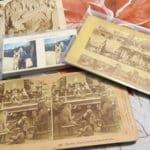
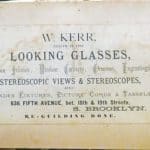

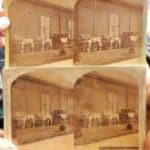
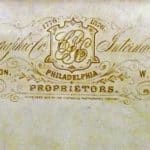

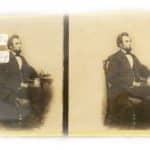



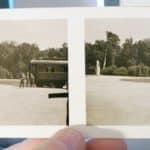

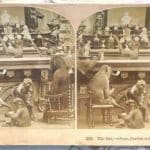




Related posts: